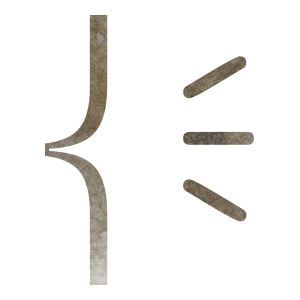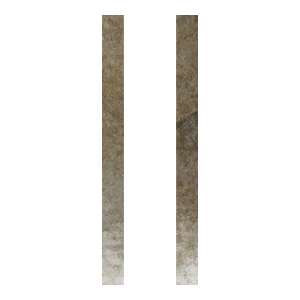The marks they leave are found in apartment buildings, under old staircases, on wood railings or cellar doors, sometimes even inside elevators. Scratch-like, just a line or two with a kind of odd flourish, as if engraved with a crooked hook. They are easily mistaken for random acts of vandalism, which of course is what they want you to take them for. Like patterns that are not really patterns, as meaningless as the creases on an old hand. And yet, exactly like palms, they can be read.
“Miserable dog”. It is well-known that they don’t like dogs to suffer. A woman had a dog who she named Greta. When the woman moved to the City she couldn’t afford an apartment with a terrace or a garden, but rented a very small apartment. The woman went to work all day, and came home exhausted. In the beginning, Greta was well-behaved. But as time went on the dog grew more and more lonely. It peed on the carpet, burrowed into the sofa stuffing, shredded the curtains. The woman had little money, and couldn’t afford to replace her ruined possessions. She didn’t care about them so much, but her parents visited from time to time and she had to make them believe that she was doing well. The woman had told them she had won a scholarship at the City’s university and was studying to be a doctor. The good curtains, the sofa, the carpet, were all essential to the act. Greta wasn’t.
The woman tried to give the dog to friends, she sought help from her neighbours. But she had few friends, and the neighbours didn’t trust her because of her job. So she had no choice but to give Greta away. When somebody answered the ad she had put in the newspaper, the woman cried. The dog put its nose in her lap and tried to console her but of course that only made her sadder. The next day, when the woman woke up, she felt there was something wrong. Someone had broken into her house. Yet the thieves had not stolen a thing: they had stolen a someone. There was a card. The card said that if the woman wanted to see Greta again she had to pay. The sum wasn’t very much, but for the woman it was almost impossible. All of her meager earnings went to pay the rent.
So the woman sold all her furniture: the curtains, the carpet, the sofa, all of it. Finally she realized the one reason why she had been able to carry on for so long was not the City’s unaffordable dreams, but Greta. Without the dog, she couldn’t live. So the woman paid the ransom and went to pick up the dog. When she arrived at the meeting place, no one was there. She waited and waited, but no one came. She became so desperate she thought of going to the police; but the police are rarely fond of people like her. She returned home in despair, but when she arrived she found her door open. Greta! The dog ran to her, barking happily. The woman hugged the dog tight. Then she looked up slowly, shocked. Her room was completely re-furnished with all the things she had sold. It was then that she understood that the City’s dreams were not for her. That very same day she took all her belongings and Greta, and left town. None of her clients ever saw her again, and her parents never suspected the kind of life she had led in the City.
So if they take, but also give back, is ‘thief’ the right word? Or is the word we are looking for like one of their marks, a shape that we must interpret? How many of them are there? What are they? Do they mean us harm or good? That is the hardest question to answer. Everything they do is tied to our homes. They inhabit them, take what we thought couldn’t be taken, give what we thought could not be given. They have their own reasons, and they don’t share them with us.
“A son’s gift”. Many years ago, a father promised his young son that he would buy him an ice cream if the boy solved a math problem all on his own. The boy struggled with it for two long hours before succeeding. While the boy worked, his father was on the phone, busy with a long business call. When the father finally finished, all the shops had closed. So he promised his son that he would buy him an ice cream the next day. It was the very first time that the son truly hated his father.
Forty-two years later, in the same house, the father lay dying. One day the son had to run a business errand, and left his father with the nurse. When he returned he heard laughing. The nurse and his father were eating from a huge bowl of chocolate ice cream. The nurse had found it on the kitchen table, along with a small gift card with a date on it, a date from forty-two years ago. The father looked up and smiled. “I thought you would never forgive me,” he said. The son wanted to reply, but he burst out crying. Later, this was the last memory he had of his father, the memory of them eating their long-awaited ice cream together, and talking and telling stories and jokes from the past.
This mark means “on this floor they dream well”. Why exactly this might matter is not clear, unless of course they steal dreams. In the City there is a little tale about this mark. One day it appeared on the door of an apartment belonging to an old couple, a couple who had lived through two wars, the death of a stillborn child, two break-ups and an infinite number of small misfortunes. Yet the old couple’s dreams were so beatiful street sweepers would stop every morning under their windows, as the old couple recounted their dream tales to each other.
In these dreams there were no fantastical landscapes, no talking beasts, no voice of prophecy. Instead they dreamt of going to the post office, shopping at the grocer’s, calling their son on the phone; in fact the dreams were so similar to their days that it was hard to tell them apart. But there was one difference: in their dreams the couple was no longer old, and their ages changed from dream to dream. Sometimes they were teenagers, sometimes newlyweds, sometimes children. As teenagers they went to the post office, laughing out loud at jokes that only they could understand; or once again they were young and very much in love, stealing kisses behind the vegetable display; they became small children, stomping in rain puddles, all while somehow going over the news of the day with their son. In their dreams they lived from the point of view of death: everything they had been was with them, at all times. Only in the waking world they forgot, for oblivion can only be killed in sleep.
One summer night the old couple came home and found their door ajar. Someone had broken in. Dismayed, they took stock of their possessions: everything was in its place. Yet that night they had no dreams. Nor did they dream the next night, or the one after. The street sweepers waited in vain under their windows, but there were no early morning dream-tales to be heard. Two weeks later, after forty-seven years of marriage, the old couple broke up. They could no longer sustain each other’s presence. Who was that flabby old boy? Who was that wrinkled old girl? Strangers now, even to themselves, they parted without a word, eyes downcast, as if they were trying to remember a dream that had long been forgotten.
It cannot be a coincidence that so many of their thefts happen during sleep, or right after it. It is as if wakefulness disturbs them. Not because they cannot act in plain day, but because dream is the place they come from. This, it is said, is the reason why nobody has ever caught them in the act; because the act doesn’t happen in our home, but in the dream-mirror of it, the one behind our eyelids.
This sign appeared near the apartment of two friends who’d had a terrible fight. It is a warning, and as such it must be taken. The two had argued about a girlfriend. One friend told the other that his girlfriend was the most stupid human being he had ever met; the other replied that his friend was the most annoying jerk who to ever draw a breath. Both statements were correct.
So the two swore they would never see each other again. The problem was, they shared the same flat. It took them an entire week to disentangle their music collections, their books, their clothes. Then, the night before moving out, they had a dream. In their dream each one called the other’s name but couldn’t find him. When they finally found each other, a glass divided them, a vast, paper-thin glass. But strangely, they couldn’t tell who was who, whether they were the man on one side of the glass, or the other. When they woke up they found the apartment door open. Someone had gone through their possessions. Nothing had been taken, but everything was out of order. Well, not exactly. All their belongings were still in their boxes, but their memories of them were in disarray.
The memory of each object, along with the story attached to it, had been relocated to the other friend’s mind. A favorite record, still in the box, had now become the other friend’s favorite record. All the fondness attached to a scarf, a pair of shoes, a board game, a novel, had been exchanged between the friends. Dismayed, they had to pull out all the things they had packed away and sort them out again. As they were doing so, the first friend’s girlfriend rang the bell and came up. When she opened the door the two friends gasped. They couldn’t remember – not even to save their own lives – whose girlfriend she was.
Mischievous. Is that a good definition of what they are? Maybe they are not abstract entities, geometric constructs like the signs they draw. What if they are more like children? What if the burglaries, the thefts, the ransom messages, what if it is all a game? And us? Do we exist when they are not playing?
A very last one. In an alphabet of treachery, this is the most treacherous of signs: “Lost lover’s memory”. Here in the City, when someone wants to forget an old lover, they can take the lover’s gifts and lay them on the main table of the house, like an offering. Tradition has it that it must be the first day of winter, when homes are the warmest, and they are the strongest. Perhaps it is no coincidence that this day is so near the Day of the Dead, for memories of old lovers belong to the netherworld. After the objects are placed on the table, usually at night, they are never seen again. Not only do they disappear, but all memory of them also vanishes. Is this ritual a plea for oblivion? A request for forgetting? Not exactly. For each thing that they take they give something in return; even when what they give is the absence of what was taken. For an entire week after they take the offering, you experience the gifts again, for the first time. Not for the last, for the first. You can no longer ‘remember’ those gifts, because they are happening to you at that very moment.
So in the week after the Day of the Dead it is said that the City is inhabited by ghosts, the tender ghosts of lovers’ gifts. Not the flashy gifts – those they leave undisturbed – not engagement rings but tea kettles, not earrings but coffee cups, not expensive clothes but second-hand books; these are the objects they bring back to life. And along with the objects, the person who gave them. For a week or so the lost lover returns, not as a memory, but as a real person.
You would be watching telly alone when she would come in from the kitchen, bringing your ‘new cup’, and you would tease her about it, you would it call it silly, but then she would smile at you, because she knows, and you know; and you would keep on watching tv like nothing had happened, only slowly realizing something had been taken from you, something vital. You would turn, and she would be gone, only the warm impression of her twin cup on the table would remain, until that would fade too, and then you would cry, without really understanding if what you felt was the most terrible joy or the most blissful pain.
This is what it means to have dealings with them: to gain from loss, to lose from gain. We cannot defend ourselves from them. No one can. We can only look for their signs, not to prepare for what comes next, but to accept it, to make room in our lives so that we might relish their dream burglaries, their impossible thefts, the little games they play with us in order for our homes to exist.

Giovanni De Feo
Giovanni De Feo is a storyteller and teacher who has lived and worked in the Netherlands and in the United Kingdom for several years. He is published author of speculative fiction and a screenwriter. He has no dog, no cats, no spouse, nor any circus fleas, but he is very keen on collecting masks on his living room wall. He doesn’t find their constant whispering unsettling at all, though others occasionally do. He lives and works in Genoa.
-
tania
-
MarioFlying
-
Ainsley Mae
-
Giovanni De Feo
-








